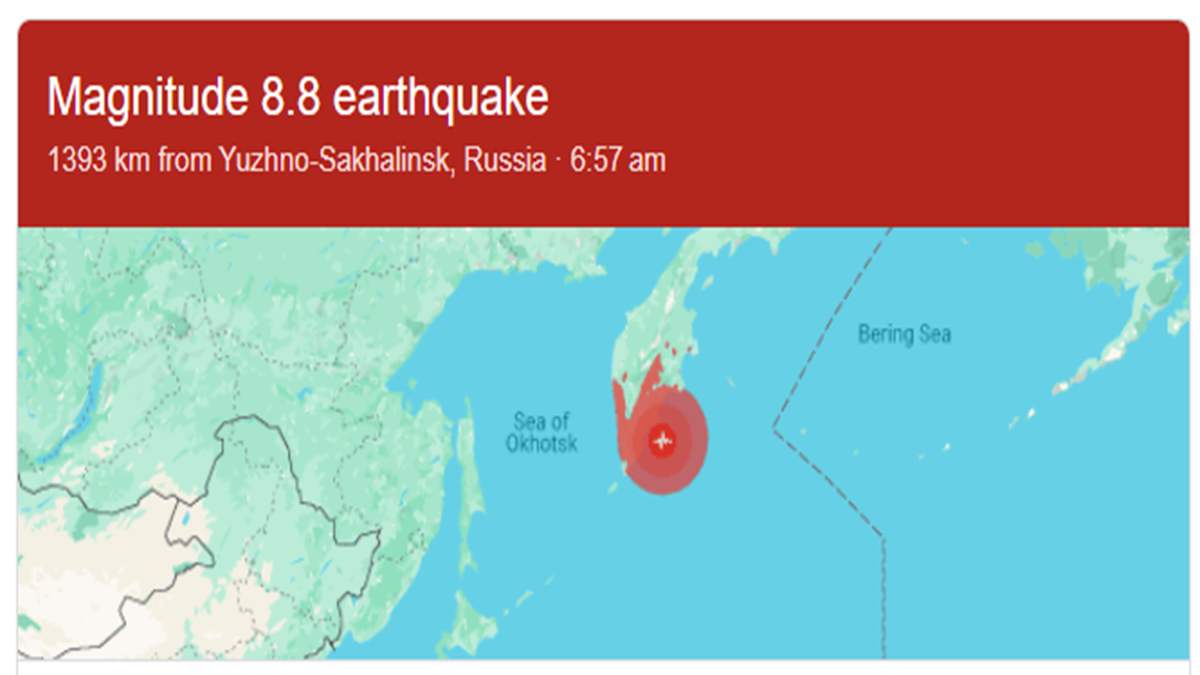On July 30, 2025, a powerful 8.8-magnitude earthquake struck off the coast of Russia’s Kamchatka Peninsula, marking one of the most significant seismic events in recent history. This earthquake, among the top six strongest ever recorded, sent shockwaves across the Pacific region, triggering widespread tsunami warnings. In Kamchatka, waves up to 5 meters inundated coastal areas, causing significant damage to infrastructure, including the destruction of a kindergarten building.
The quake’s impact extended far beyond Russia’s borders. Tsunami waves reached as far as Hawaii, Japan, and the U.S. West Coast, prompting evacuations and emergency responses. In Hawaii, waves up to 5.7 feet were recorded, leading to the evacuation of coastal areas and the temporary abandonment of cruise ships that had docked in anticipation of the tsunami.
Despite the initial severity, the situation was mitigated by timely warnings and preparedness measures. However, the event serves as a stark reminder of the Pacific Ring of Fire’s seismic volatility and the ongoing need for vigilance and preparedness in earthquake-prone regions.
Russia Earthquake and Japan Tsunami 2025
Natural disasters are an inevitable part of our planet’s geological processes, but the scale of destruction they bring can be overwhelming. Among the most significant natural calamities, earthquakes and tsunamis have been responsible for countless fatalities, widespread devastation, and global concern. Two such events that have had a lasting impact on both local and global levels are the Russia Earthquake and the Japan Tsunami.
The Russia Earthquake: A Powerful Tremor
In recent years, Russia has experienced some seismic activity that has captured global attention, particularly its more active regions like the Kamchatka Peninsula and Siberia. Though Russia is not traditionally known for its devastating earthquakes, the 2011 earthquake that hit the Russian Far East and its aftermath are still remembered.
The Kamchatka Peninsula: A Seismic Hotspot
The Kamchatka Peninsula in eastern Russia is one of the most seismically active regions in the world due to its location along the Ring of Fire. This area is prone to frequent earthquakes, many of which are of a moderate to strong magnitude. The 2011 earthquake with a magnitude of 8.3 was a reminder of the seismic potential in the region. The earthquake resulted in minimal casualties, thanks to the preparedness and low population density of the area, but it still caused significant damage to infrastructure.
How Russia Prepared for the Earthquake
Despite the destructive potential of this earthquake, Russia has made significant strides in improving its seismic preparedness. This event highlighted the need for more comprehensive building codes, early warning systems, and disaster response protocols. Russia’s efforts in seismic monitoring are crucial for mitigating future risks, especially as seismic activity remains a frequent threat.
Reasons for Russian Earth Quake
Earthquakes in Russia, like in other parts of the world, are primarily caused by the movement of tectonic plates. Russia experiences seismic activity, particularly in regions near fault lines or plate boundaries. Here are some of the main reasons behind earthquakes in Russia:
1. Tectonic Plate Movements
Russia spans several tectonic plate boundaries, which are areas where massive slabs of the Earth’s crust are in motion. The main types of plate interactions that cause earthquakes are:
-
Subduction Zones: Areas where one tectonic plate is forced under another, such as the Pacific Plate beneath the Eurasian Plate along the Kamchatka Peninsula.
-
Collision Zones: Regions where two plates collide, causing immense pressure and resulting in earthquakes. This occurs along the Caucasus region, for example.
-
Transform Boundaries: Places where plates slide past each other, leading to earthquakes, particularly in the western part of Russia.
2. Subduction Zones
The Kamchatka Peninsula and the Kuril Islands are near the Pacific Plate, which is subducting beneath the Eurasian Plate. This zone of subduction creates a significant amount of seismic activity, including major earthquakes.
3. Tectonic Compression and Crustal Stress
The collision of the Indian Plate with the Eurasian Plate has been responsible for significant geological processes like the formation of mountain ranges (e.g., the Himalayas). This ongoing collision leads to crustal stress that propagates through various parts of Russia, especially in its southeastern and eastern regions.
4. Human Activities
-
Mining and Reservoir-Induced Seismicity: Large-scale human activities, such as deep mining or the filling of large reservoirs, can sometimes induce small to moderate seismic events. Although not a major cause in Russia, this can still be a contributing factor in certain localized regions.
-
Hydroelectric Dams: Certain large dams in Russia, such as those along the Volga River, can influence seismic activity if the pressure from the water body affects local fault lines.
5. Fault Zones
Russia has several active fault zones, especially in the far eastern regions (e.g., the Sakhalin Island and the Kamchatka Peninsula). These faults can generate earthquakes when stress builds up along the fault lines, which is later released in the form of seismic waves.
6. Volcanic Activity
Russia is home to several active volcanoes, particularly in the Kamchatka Peninsula, and volcanic eruptions are often accompanied by earthquakes. The movement of magma beneath the Earth’s surface creates pressure that can cause minor to moderate tremors.
In summary, earthquakes in Russia are primarily caused by the dynamic and complex interaction of tectonic plates, subduction zones, fault lines, and volcanic activity. Although seismic activity is more common in certain regions, it is an ongoing natural process due to the Earth’s constantly changing surface.
Japan Tsunami: A Catastrophic Event
On March 11, 2011, Japan experienced one of the deadliest natural disasters in modern history, when a massive earthquake off the coast triggered a devastating tsunami. Known as the Tohoku Tsunami, it swept across Japan’s coastline and caused unimaginable destruction.
The Earthquake and Tsunami: The Prelude to Disaster
The 2011 Tōhoku earthquake was one of the largest in recorded history, with a magnitude of 9.0. Its epicenter was located off the coast of Sendai, Japan. The earthquake’s impact was immense, but what followed was even more catastrophic — a tsunami with waves as high as 40 meters (130 feet) that surged into coastal towns. The tsunami completely obliterated cities, leaving behind widespread damage and causing severe flooding in low-lying regions.
The Impact on Japan’s Population and Infrastructure
The tsunami wreaked havoc, particularly in the Fukushima Prefecture, where the destruction was compounded by the catastrophic failure of the Fukushima Daiichi Nuclear Power Plant. Thousands of lives were lost, and millions were displaced. The tsunami’s powerful waves caused extensive damage to buildings, roads, and other vital infrastructure, resulting in long-term economic setbacks for the country.
Recovery Efforts: A Testament to Japan’s Resilience
Japan’s response to the disaster has been widely praised. Immediate search-and-rescue operations were carried out, and the Japanese government implemented an effective disaster management strategy. Recovery efforts in the affected regions have been ongoing, and Japan has since invested heavily in rebuilding and strengthening its infrastructure, especially with regard to coastal defenses and early warning systems.
Lessons Learned and Global Impact
Both the Russia earthquake and the Japan tsunami offer valuable lessons about natural disaster preparedness, response, and recovery. While Russia’s seismic preparedness continues to improve, Japan’s experience with the 2011 tsunami has spurred innovations in disaster risk management.
Strengthening Earthquake and Tsunami Preparedness Worldwide
The global response to these disasters emphasized the importance of international cooperation in disaster management. Countries are now working together to share knowledge, provide aid, and develop early warning systems that could save countless lives in the event of similar catastrophes. Additionally, the United Nations and other global organizations have pushed for stricter regulations on construction standards in earthquake-prone regions.
Conclusion: Nature’s Fury and Humanity’s Resilience
Both the Russia earthquake and the Japan tsunami serve as grim reminders of the powerful forces of nature. However, they also highlight humanity’s remarkable ability to respond, recover, and adapt in the face of overwhelming disaster. As technology improves and disaster preparedness strategies evolve, we hope that future seismic events can be met with better resilience and greater protection for vulnerable populations.

